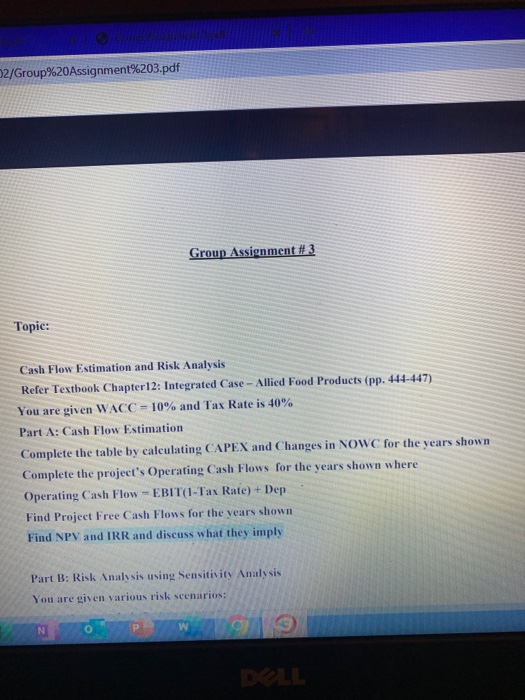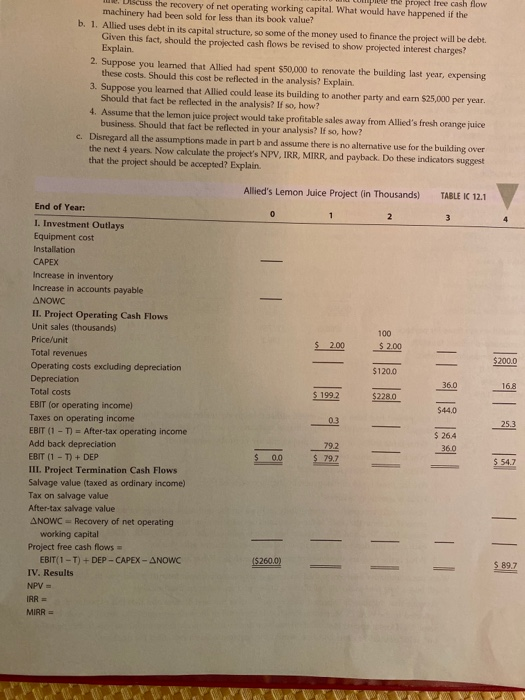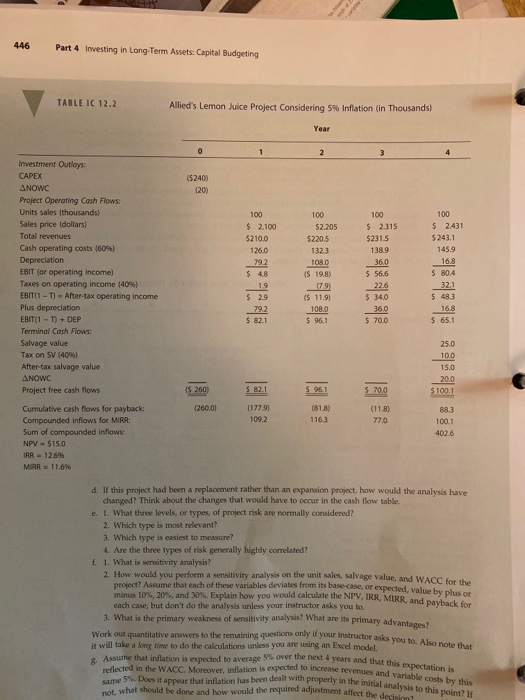12/Group%20Assignment%203.pdf Group Assignment #3 Topic: Cash Flow Estimation and Risk Analysis Refer Textbook Chapter 12: Integrated Case - Allied Food Products (pp. 444-447) You are given WACC = 10% and Tax Rate is 40% Part A: Cash Flow Estimation Complete the table by calculating CAPEX and Changes in NOW for the vears shown Complete the project's Operating Cash Flows for the years shown where Operating Cash Flow - EBIT(I-Tax Rate) + Dep Find Project Free Cash Flows for the years shown Find NPV and IRR and discuss what they imply Part B: Risk Analysis using Sensitivity Analysis You are given various risk scenarios: NO PW9 DELL Cumple the project free cash flow Discuss the recovery of net operating working capital. What would have happened if the machinery had been sold for less than its book value? B. 1. Allied uses debt in its capital structure, so some of the money used to finance the project will be debt. Given this fact, should the projected cash flows be revised to show projected interest charges? Explain. 2. Suppose you learned that Allied had spent $50,000 to renovate the building last year, expensing these costs. Should this cost be reflected in the analysis? Explain 3. Suppose you learned that Allied could lease its building to another party and earn $25,000 per year. Should that fact be reflected in the analysis? If so, how? 4. Assume that the lemon juice project would take profitable sales away from Allied's fresh orange juice business. Should that fact be reflected in your analysis? If so, how? c. Disregard all the assumptions made in part b and assume there is no alternative use for the building over the next 4 years. Now calculate the project's NPV, IRR, MIRR, and payback. Do these indicators suggest that the project should be accepted? Explain. Allied's Lemon Juice Project (in Thousands) TABLE IC 12.1 | End of Year: 1. Investment Outlays Equipment cost Installation CAPEX Increase in Inventory Increase in accounts payable ANOWC IL Project Operating Cash Flows Unit sales (thousands) Price/unit Total revenues Operating costs excluding depreciation Depreciation Total costs EBIT (or operating income) Taxes on operating income EBIT (1 - 1) = After-tax operating income Add back depreciation EBIT (1 -T) + DEP III. Project Termination Cash Flows Salvage value (taxed as ordinary income) Tax on salvage value After-tax salvage value ANOWC - Recovery of net operating working capital Project free cash flows = EBIT(1-T) + DEP - CAPEX - ANOWC IV. Results NPV = IRR = MIRR = | (5260,0) 11 W WW.V. 446 Part 4 Investing in Long-Term Assets: Capital Budgeting TABLE IC 12.2 Allied's Lemon Juice Project Considering 5 Inflation (in Thousands) (5240) (20) 100 100 $ 2315 $231.5 1389 360 Investment Outlays: CAPEX ANOWC Project Operating Cash Flows: Units sales (thousands) Sales price (dollars) Total revenues Cash operating costs (609) Depreciation EBIT (or operating income) Taxes on operating income (40%) EBIT(1 - 1) After-tax operating income Plus depreciation EBIT(1 - T) + DEP Terminal Cash Flows: Salvage value Tax on SV (40%) After-tax salvage value ANOWC Project free cash flows 100 $ 2.100 $210.0 1260 792 $ 4.8 1.9 $ 29 792 $ 82.1 100 $2.205 $220.5 1323 1080 IS 198) 79) $ 119 108.0 $ 96.1 $ 566 226 $ 340 36.0 $ 2431 $ 243.1 145.9 16.8 $ 804 32.1 $ 48.3 16.8 $ 65.1 $ 70.0 25.0 10.0 15.0 20.0 1$ 260 $ 100.1 (260.01 $ 82.1 (1779) 109.2 0818 1163 $ 700 (118) 77.0 883 100.1 4026 Cumulative cash flows for payback: Compounded inflows for MIRR: Sum of compounded inflows: NPV - $15.0 IRR = 12.696 MRR = 11.646 d. If this project had been a replacement rather than an expansion project, how would the analysis have changed? Think about the changes that would have to occur in the cash flow table. e. 1. What three levels, or types of project risk are normally considered? 2. Which type is most relevant? 3. Which type is easiest to measure? 4. Are the three types of risk generally highly correlated? f. 1. What is sensitivity analysis? 2. How would you perform a sensitivity analysis on the unit sales, salvage value, and WACC for the proiect! Assume that each of these variables deviates from its base-case, or expected valuable minus 10% 20% and 30% Explain how you would calculate the NPV, IRR, MIRR and MIRR, and payback for each case, but don't do the analysis unless your instructor asks you to 3. What is the primary weakness of sensitivity analysis? What are its primary advantage Work out quantitative answers to the remaining questions only if your instructor asks it will take a long time to do the cakulations unless you are using an Excel model over the next years and that this expectation is Assume that inflation is expected to average 5% over the next 4 years and that the reflected in the WACC. Moreover, inflation is exp is expected to increase revenues and variable costs to this sume 5%. Does it appear that inflation has been dealt with properly in the initial ot, what should be done and how would the require adjustment affect the desire stions only if your instructor asks you to. Also note that dealt with properly in the initial analysis to this point 12/Group%20Assignment%203.pdf Group Assignment #3 Topic: Cash Flow Estimation and Risk Analysis Refer Textbook Chapter 12: Integrated Case - Allied Food Products (pp. 444-447) You are given WACC = 10% and Tax Rate is 40% Part A: Cash Flow Estimation Complete the table by calculating CAPEX and Changes in NOW for the vears shown Complete the project's Operating Cash Flows for the years shown where Operating Cash Flow - EBIT(I-Tax Rate) + Dep Find Project Free Cash Flows for the years shown Find NPV and IRR and discuss what they imply Part B: Risk Analysis using Sensitivity Analysis You are given various risk scenarios: NO PW9 DELL Cumple the project free cash flow Discuss the recovery of net operating working capital. What would have happened if the machinery had been sold for less than its book value? B. 1. Allied uses debt in its capital structure, so some of the money used to finance the project will be debt. Given this fact, should the projected cash flows be revised to show projected interest charges? Explain. 2. Suppose you learned that Allied had spent $50,000 to renovate the building last year, expensing these costs. Should this cost be reflected in the analysis? Explain 3. Suppose you learned that Allied could lease its building to another party and earn $25,000 per year. Should that fact be reflected in the analysis? If so, how? 4. Assume that the lemon juice project would take profitable sales away from Allied's fresh orange juice business. Should that fact be reflected in your analysis? If so, how? c. Disregard all the assumptions made in part b and assume there is no alternative use for the building over the next 4 years. Now calculate the project's NPV, IRR, MIRR, and payback. Do these indicators suggest that the project should be accepted? Explain. Allied's Lemon Juice Project (in Thousands) TABLE IC 12.1 | End of Year: 1. Investment Outlays Equipment cost Installation CAPEX Increase in Inventory Increase in accounts payable ANOWC IL Project Operating Cash Flows Unit sales (thousands) Price/unit Total revenues Operating costs excluding depreciation Depreciation Total costs EBIT (or operating income) Taxes on operating income EBIT (1 - 1) = After-tax operating income Add back depreciation EBIT (1 -T) + DEP III. Project Termination Cash Flows Salvage value (taxed as ordinary income) Tax on salvage value After-tax salvage value ANOWC - Recovery of net operating working capital Project free cash flows = EBIT(1-T) + DEP - CAPEX - ANOWC IV. Results NPV = IRR = MIRR = | (5260,0) 11 W WW.V. 446 Part 4 Investing in Long-Term Assets: Capital Budgeting TABLE IC 12.2 Allied's Lemon Juice Project Considering 5 Inflation (in Thousands) (5240) (20) 100 100 $ 2315 $231.5 1389 360 Investment Outlays: CAPEX ANOWC Project Operating Cash Flows: Units sales (thousands) Sales price (dollars) Total revenues Cash operating costs (609) Depreciation EBIT (or operating income) Taxes on operating income (40%) EBIT(1 - 1) After-tax operating income Plus depreciation EBIT(1 - T) + DEP Terminal Cash Flows: Salvage value Tax on SV (40%) After-tax salvage value ANOWC Project free cash flows 100 $ 2.100 $210.0 1260 792 $ 4.8 1.9 $ 29 792 $ 82.1 100 $2.205 $220.5 1323 1080 IS 198) 79) $ 119 108.0 $ 96.1 $ 566 226 $ 340 36.0 $ 2431 $ 243.1 145.9 16.8 $ 804 32.1 $ 48.3 16.8 $ 65.1 $ 70.0 25.0 10.0 15.0 20.0 1$ 260 $ 100.1 (260.01 $ 82.1 (1779) 109.2 0818 1163 $ 700 (118) 77.0 883 100.1 4026 Cumulative cash flows for payback: Compounded inflows for MIRR: Sum of compounded inflows: NPV - $15.0 IRR = 12.696 MRR = 11.646 d. If this project had been a replacement rather than an expansion project, how would the analysis have changed? Think about the changes that would have to occur in the cash flow table. e. 1. What three levels, or types of project risk are normally considered? 2. Which type is most relevant? 3. Which type is easiest to measure? 4. Are the three types of risk generally highly correlated? f. 1. What is sensitivity analysis? 2. How would you perform a sensitivity analysis on the unit sales, salvage value, and WACC for the proiect! Assume that each of these variables deviates from its base-case, or expected valuable minus 10% 20% and 30% Explain how you would calculate the NPV, IRR, MIRR and MIRR, and payback for each case, but don't do the analysis unless your instructor asks you to 3. What is the primary weakness of sensitivity analysis? What are its primary advantage Work out quantitative answers to the remaining questions only if your instructor asks it will take a long time to do the cakulations unless you are using an Excel model over the next years and that this expectation is Assume that inflation is expected to average 5% over the next 4 years and that the reflected in the WACC. Moreover, inflation is exp is expected to increase revenues and variable costs to this sume 5%. Does it appear that inflation has been dealt with properly in the initial ot, what should be done and how would the require adjustment affect the desire stions only if your instructor asks you to. Also note that dealt with properly in the initial analysis to this point









